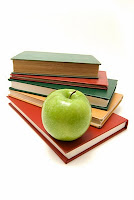It's been awhile since I introduced a new lifesaver. The start of a new school year is as good a time as any to share one with you. This one is adapted from Celebrating Every Learner: Activities and Strategies for Creating a Multiple Intelligences Classroom .
.
If you recall, my lifesavers are for those times when substitutes do not have lesson plans, or need time to fill when lesson plans run short. They are intended to be pretty flexible for most classrooms. They can also work for regular teachers looking for activities, or possibly something extra to include in case their own subs need something else for students to do.
You may not have access to many materials when you are short on lesson plans, so lifesavers should keep it pretty simple. This one does.
What you'll need: a short description to either read or recite to the class, construction paper and art supplies like color pencils and crayons, and paper and pencil.
This assignment can be a drawing, or writing assignment, or both! If you have construction paper that you can use, or even blank printer paper, let the students do this as practice with visualization. If you need a longer activity or have no construction paper, you can make this a writing assignment with pencil and paper. If you need a lot of extra time filled, you can choose both options.
What you'll do:
- Before students begin, tell them to close their eyes and listen to your words. They will practice visualizing, or creating a picture in their minds. They will use your words to inspire a drawing of something very special (or a description of something very special).
- Tell students that they took a vacation for a few weeks. When they returned, they discovered their bedroom had been transformed. Everything looks totally different! Everything that they've ever imagined would be in a perfect bedroom now greets them as they open their door. Someone who knows them very well has painted a picture of something on the ceiling. What is it? Why did they paint it? What does their new bed look like? What is now on the walls and floor of their perfect bedroom? What cool new things can they see have been added? What colors do they see? What can they smell? What music can be heard playing?
- Tell them to open their eyes and draw a picture of the perfect bedroom that they saw in their minds. What would this room be like as they entered? As they begin to draw or write, you can write a few words on the board that will help them remember what to include (ceiling, walls, floor, bed, new things, colors, smell, music).
- If they are making a drawing, tell them to draw and label the new features on their room. If they are writing, tell them to write a story or description about finding this new room. Have them practice using imagery by describing what the room did to all five of their senses.
- Have students share their designs and descriptions with the class. Ask the class what the things included in the room reveal about the person who visualized it.
As you can see, this simple assignment doesn't require much in terms of printouts and extra materials. You can do this activity with several grade levels. With young students, I like to tell them to fold the construction paper in half, then draw a picture on one side and write on the other.
The students' imaginations carry the assignment, and they may even find it interesting to come up with ideas. The activity also is not simply "busywork," as it gives students a chance to practice a skill needed for reading comprehension (visualization) and a chance to work creatively. Give it a try if you ever find yourself in a bind.











































